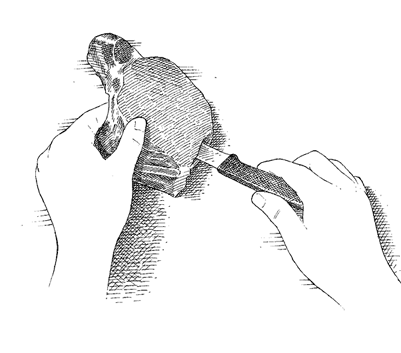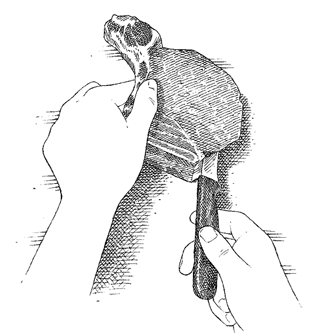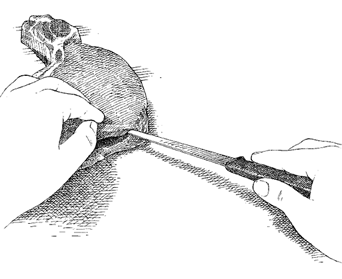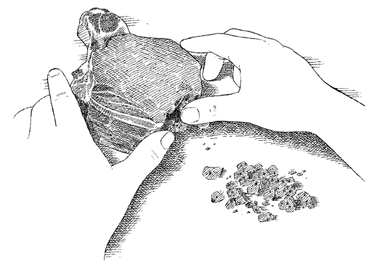The Cook's Illustrated Cookbook (185 page)
Read The Cook's Illustrated Cookbook Online
Authors: The Editors at America's Test Kitchen
Tags: #Cooking

MAKES ENOUGH FOR 1 RECIPE
STUFFED THICK-CUT PORK CHOPS
1 | tablespoon olive oil |
1 | large red onion, halved and sliced ¹⁄ |
1 | tablespoon sugar |
¹⁄ | cups chopped dates |
¹⁄ | cup dried tart cherries |
³⁄ | cup ruby port |
1 | orange, cut into 4 wedges |
3 | tablespoons white wine vinegar |
2 | teaspoons minced fresh thyme |
¹⁄ | teaspoon salt |
Pepper | |
¹⁄ | cup pecans, toasted |
1.
Heat oil in medium saucepan over medium heat until shimmering; add onion and sugar and cook, stirring occasionally, until beginning to color, 20 to 25 minutes. Meanwhile, combine dates, cherries, and port in bowl; cover and microwave until simmering, about 1 minute. Set aside until needed. Squeeze juice from orange wedges into small bowl; reserve juiced wedges for sealing stuffing pockets in chops.
2.
When onions are soft, add dried fruit mixture, ¹⁄
4
cup orange juice, 2 tablespoons vinegar, thyme, salt, and pepper to taste; continue to cook, stirring occasionally, until mixture is jamlike, 10 to 12 minutes. Stir in remaining 1 tablespoon vinegar and pecans; transfer to bowl and cool until just warm, about 15 minutes.
MAKES ENOUGH FOR 1 RECIPE
STUFFED THICK-CUT PORK CHOPS
Either whole-milk or part-skim ricotta work in this recipe.
1 | slice hearty white sandwich bread, torn into quarters |
¹⁄ | cup pine nuts, toasted |
1 | tablespoon olive oil |
2 | garlic cloves, minced |
6 | ounces baby |
2 | ounces Italian fontina cheese, shredded (¹⁄ |
¹⁄ | cup |
1 | ounce Parmesan cheese, grated (¹⁄ |
1 | lemon, cut into 4 wedges |
¹⁄ | teaspoon salt |
Pinch ground nutmeg | |
Pepper |
1.
Pulse bread and pine nuts in food processor until evenly ground, about 10 pulses.
2.
Heat oil in 12-inch skillet over medium-high heat until shimmering; add garlic and cook, stirring constantly, until fragrant, about 30 seconds. Add spinach; using tongs, turn spinach to coat with oil. Cook, stirring with tongs, until spinach is wilted, about 2 minutes. Transfer spinach to colander set in sink and gently squeeze to release excess moisture; cool spinach until just warm.
3.
Combine fontina, ricotta, and Parmesan in bowl. Add spinach and bread-crumb mixture; using spatula, mix well to break up clumps. Squeeze juice from lemon wedges into bowl; reserve juiced wedges for sealing stuffing pockets in chops. Stir 1 tablespoon lemon juice, salt, nutmeg, and pepper to taste into stuffing.

1.
With knife positioned as shown, insert blade through center of side of chop until tip touches bone.

2.
Holding chop firmly, carefully swing tip of blade through middle of chop to create pocket.

3.
Remove knife from chop and, if necessary, enlarge pocket opening to measure 1 inch.

4.
With your fingers, gently press stuffing mixture into pocket, without enlarging opening.
![]() WHY THIS RECIPE WORKS
WHY THIS RECIPE WORKS
When done right, baked breaded pork chops are the ultimate comfort food—tender cutlets surrounded by a crunchy coating that crackles apart with each bite. But use a packaged supermarket breading and you get a thin, sandy crust. Make your own breading and you have different problems: a soggy, patchy crust that won’t stick to the meat. For breaded pork chops with a thick coating that wouldn’t fall off in the oven, we made a quick, batterlike egg wash by whisking enough flour into an egg white and mustard mixture to give it the consistency of mayonnaise. Once the chops were coated in this powerful glue, they held on to our flavorful mixture of toasted bread crumbs, garlic, Parmesan, and herbs. Chops that were between ³⁄
4
and 1 inch thick gave us just the right ratio of meat to crust, and baking the chops in the oven (rather than frying) eliminated the need for excess oil.
SERVES 4
If the pork is enhanced (injected with a salt solution), do not brine in step 1, and season with salt in step 4.
Salt and pepper | |
4 | (6- to 8-ounce) boneless pork chops, ³⁄ |
4 | slices hearty white sandwich bread, torn into 1-inch pieces |
2 | tablespoons vegetable oil |
1 | small shallot, minced |
3 | garlic cloves, minced |
2 | tablespoons grated Parmesan cheese |
2 | tablespoons minced fresh parsley |
¹⁄ | teaspoon minced fresh thyme |
¹⁄ | cup plus 6 tablespoons all-purpose flour |
3 | large egg whites |
3 | tablespoons Dijon mustard |
Lemon wedges |
1.
Adjust oven rack to middle position and heat oven to 350 degrees. Dissolve 3 tablespoons salt in 1¹⁄
2
quarts cold water in large container. Submerge chops in brine, cover, and refrigerate for 30 minutes to 1 hour. Remove chops from brine and thoroughly pat dry with paper towels.
2.
Meanwhile, pulse bread in food processor until coarsely ground, about 8 pulses (you should have about 3¹⁄
2
cups crumbs). Transfer crumbs to rimmed baking sheet and add oil, shallot, garlic, ¹⁄
4
teaspoon salt, and ¹⁄
4
teaspoon pepper. Toss until crumbs are evenly coated with oil. Bake until deep golden brown and dry, about 15 minutes, stirring twice during baking time. (Do not turn off oven.) Cool to room temperature. Add crumbs to Parmesan, parsley, and thyme. (Bread-crumb mixture can be prepared up to 3 days in advance.)
3.
Place ¹⁄
4
cup flour in pie plate. In second pie plate, whisk egg whites and mustard until combined; add remaining 6 tablespoons flour and whisk until almost smooth, with pea-size lumps remaining.
4.
Increase oven temperature to 425 degrees. Spray wire rack with vegetable oil spray and set in rimmed baking sheet. Season chops with pepper. Dredge 1 pork chop in flour; shake off excess. Using tongs, coat with egg mixture; let excess drip off. Coat all sides of chop with bread-crumb mixture, pressing gently so that thick layer of crumbs adheres to chop. Transfer breaded chop to wire rack. Repeat with remaining 3 chops.
5.
Bake until chops register 145 degrees, 17 to 25 minutes. Let rest on rack 5 minutes before serving with lemon wedges.
TO MAKE AHEAD:
Breaded chops can be frozen for up to 1 week. Do not thaw before baking; simply increase cooking time in step 5 to 35 to 40 minutes.
Omit salt added to bread-crumb mixture in step 2. Before breading, place ¹⁄
8
-inch-thick slice Asiago cheese (about ¹⁄
2
ounce) on top of each chop. Wrap each chop with thin slice prosciutto, pressing on prosciutto so that cheese and meat adhere to one another. Proceed with recipe from step 4, being careful when handling chops so that cheese and meat do not come apart during breading.
WHY IS THAT PORK STILL PINK?
In the test kitchen, we steer clear of dishes like Parchingly Dry Pork Chops and No-Pink Pork Loin. But there’s a reason that older recipes recommend cooking pork to startlingly high internal temperatures. Years ago, when pork quality was inconsistent and trichinosis concerns ran high, pink pork was considered a safety risk, thus most recipes recommended cooking pork to 190 degrees. Today, however, the risk of trichinosis is nearly nonexistent in the United States. What’s more, even when the trichinosis parasite is present, it is killed when the temperature of the meat rises to 137 degrees.
Both the U.S. Department of Agriculture and the National Pork Board recommend cooking pork to a final internal temperature of 160 degrees. If you are concerned about contamination with salmonella (which is possible in any type of meat), you must cook the pork to 160 degrees to be certain that all potential pathogens are eliminated. Unfortunately, given the leanness of today’s pork, these recommendations result in dry, tough meat. (In fact, today’s pork has 50 percent less fat than it did 50 years ago, which explains why older recipes that called for cooking pork to 190 degrees weren’t a total disaster—all that fat kept even overcooked pork moist.)
In the test kitchen, we have found cooking modern pork beyond 150 degrees to be a waste of time and money (unless it is a fatty cut such as pork shoulder or ribs). We cook most pork to an internal temperature of 145 degrees—the meat will still be slightly rosy in the center and juicy. As the meat rests, the internal temperature will continue to climb to the final serving temperature of 150. Of course, if safety is your top concern, cook all meat (including pork) until it is well-done.
